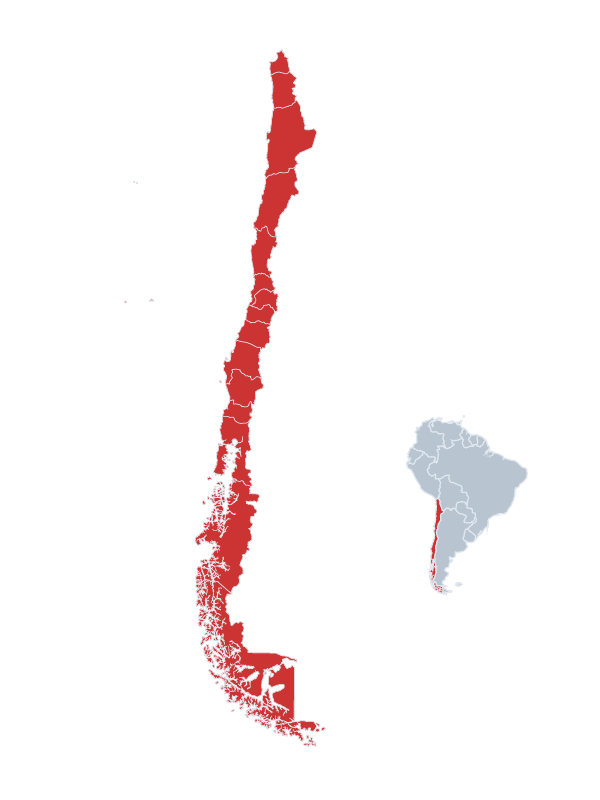Easter Island: Witness Evolution
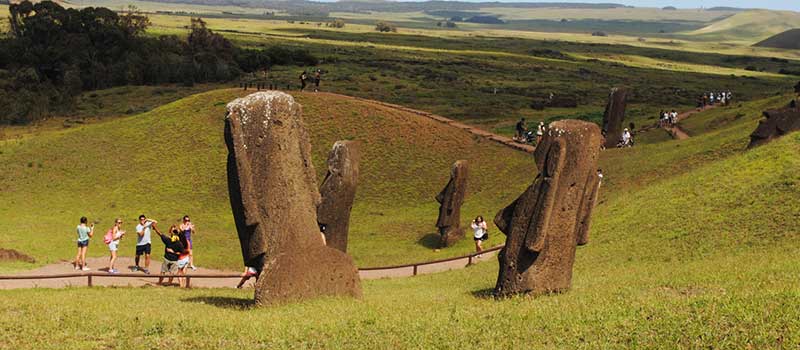
The exotic dream destination in the middle of the Pacific Ocean.
The haunting moai monoliths fashioned by the island's ancient Rapa Nui culture are true global icons, carved from an atmospheric quarry at Rano Raraku. Peer into the crater of the extinct Rano Kau volcano then visit the tribal village of Orongo. Late January/early February are special dates as the Tapati Rapa Nui festival brings a carnival vibe to the main settlement of Hanga Roa.
What can we do there?
-
Rano Kau Volcano, Orongo Ahu Vinapu and Ana Kai Tangata
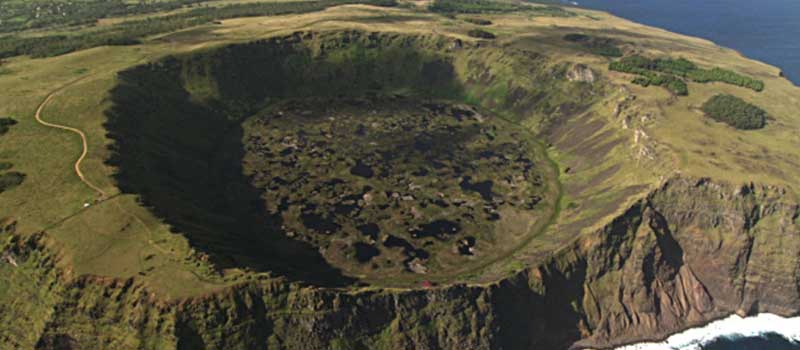
Duration: Half Day
Drive up the extinct volcano Rano Kau, appreciate on the way a view over the whole island and see its distinct geological features, proceed to an outlook at the crater lake. Afterwards drive to the ceremonial village of Orongo, where the birdman competition took place and you can see the spectacular petroglyphs related to this culture, see the 3 islets Motu Nui, Motu Iti and Motu Kao Kao opposite the coast. Orongo is located on the west edge of the Rano Raraku volcano, restored in the 1960s, presents the incredible spectacle of the crater of the Rano Kau volcano and an amazing cliff towards the sea. This was the site where the ceremony of the tangata manu, (birdman) was performed. The cliffs and Motu Nui, Motu Iti and Motu Kao islets are breathtaking views from the other side of the crater. This site has been included within the hundred sites in greater danger by the World Monument Watch. Established recent measurements of the petroglyphs indicate that these stones have slipped two meters since the last measurement made 30 years ago. Unless the rainwater redirects by the construction of a terrace to stabilize the site and tourism regulated, Orongo could collapse into the sea. Drive down again to Ahu Vinapu (not restored) and for some still proof of the influence of pre-inca arquitects in Easter Island culture. It was the altar to worship the ancestors of each family group. There are about 300 ahu on the island, techniques of construction and size may vary. This complex composes by three ahu: Vinapu I oriented towards the east coast of the winter solstice with six fallen statues in front of the ahu. Vinapu II, located right next to Vinapu I, with a two-headed statue, apparently female, possibly used for human sacrifices. Vinapu III, possibly the oldest and of which only some stones remain.
Last stop is Ana Kai Tangata, unique cave on the slopes of the Rano Kau volcano, decorated with cave paintings with motifs of the manutara, (bird of luck). This cave is the reflection of a mysterious ancient culture. Back to hotel.
-
Ahu Akivi and the Seven Moais Watching the Sea
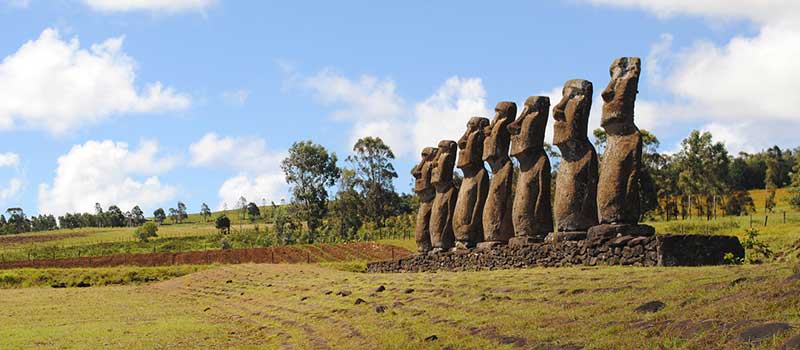
Duration: Half Day
Drive to restored Ahu Akivi with 7 Moais, built in the middle of the island. It is the first scientifically restored ahu on the island (1960-1961). This platform, unlike most, is located inland with a total length of 90 meters, on which seven-moai rise with an approximate height of 4 meters each. The ahu Akivi aligned with the points by where the sun rises on the equinoxes in spring and autumn (September 22 and March 20). Given its location to the interior of the island along farming villages, learning about the change of seasons was essential for this purpose. The legend tells us that these statues are representing the 7 explorers who were sent to Rapa Nui by the king Hotu Matua. Then, proceed to the unrestored Ahu Hanga Poukura. Then visit the topknot-quarry Puna Pau with its red scoria stone, where all the Pukaos were made. We will also visit the ceremonial site of Tahai with 3 Ahus and restored statues, remains of boathouses, a boat ramp and other features. Here we see the only statue with eyes. Back to hotel.
-
Akahanga, Rano Raraku, Ahu Tongariki, te Pito Kura, Ahu Nau Nau, and Anakena Beach
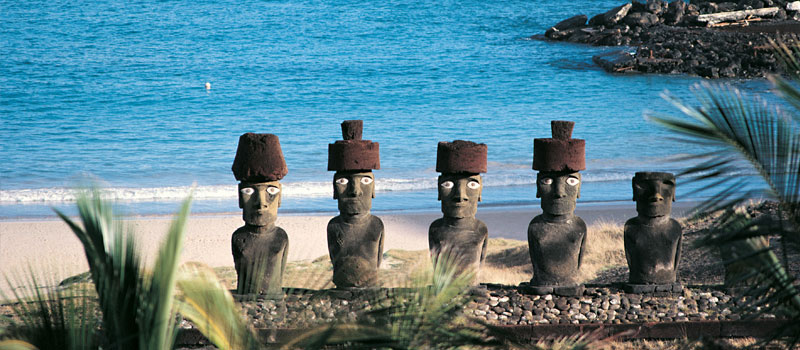
Duration: Full Day
Drive to the southcoast and visit representative examples of not restored platforms, Ahus Vaihu in the bay of Hanga Te’e, a platform which held eight moai now lying upside down in the same position they were left. The pukaos (red stone hats), being cylindrical, rolled further reaching beyond the Bay from which they were recovered from the waters of the ocean. Then Akahanga, a ceremonial 18 meters long platform which has not been restored and which allows to view the statues as found by the first European explorers. This ahu once held about a dozen of moai with sizes between 5 and 7 meters and it is also known as “the platform of the king”, possible burial place of Ariki Hotu Matu’a”, first king of the island, although archaeological digs have failed to find anything to supports this theory. Akahanga also shows the remains of several hare paenga, (boathouses), with its rare stone foundations. Proceed to Rano Raraku, quarry of almost 900 stone statues, 397 of them still lying or standing at the slopes of the extinct volcano with crater lake. Then visit Ahu Tongariki (restored with 15 Moais), most recent and biggest restoration on the island, ceremonial platform of 220 meters is the most majestic of the island with its 12 gigantic statues, framed by the sea.. Drive to the eastcoast and visit Ahu Te Pito Kura, intact platform with its moai (Paro, original name), in the position in which it was left. Te Pito Kura means “navel of light” and there are those who relate the name of the place with the special qualities of this rock, also with Te Pito Henua or “navel of the world”. Last but not least visit the beach of Anakena, a beautiful white sand beach, palm trees and turquoise waters. It was in this beach where “Hotu Matu’a” (first king of the island), arrived with his family, later used as residence, political, social and cultural center. Everyone calls it Anakena but the correct name is “Morie Hanga Roa”. Two moai platforms are in this sector. Ahu au Nau, best preserved and restored in 1980 by Sergio Rapu, consists of 7 moais, 4 with pukao in perfect condition. The second, called Atue Huki has one moai with a height of 6 meters and 3 m wide, fairly deteriorated dotted with white spots, a type of fungus that affects the statues on the island. There you will have the opportunity to enjoy the warm Pacific Ocean. Back to hotel.


